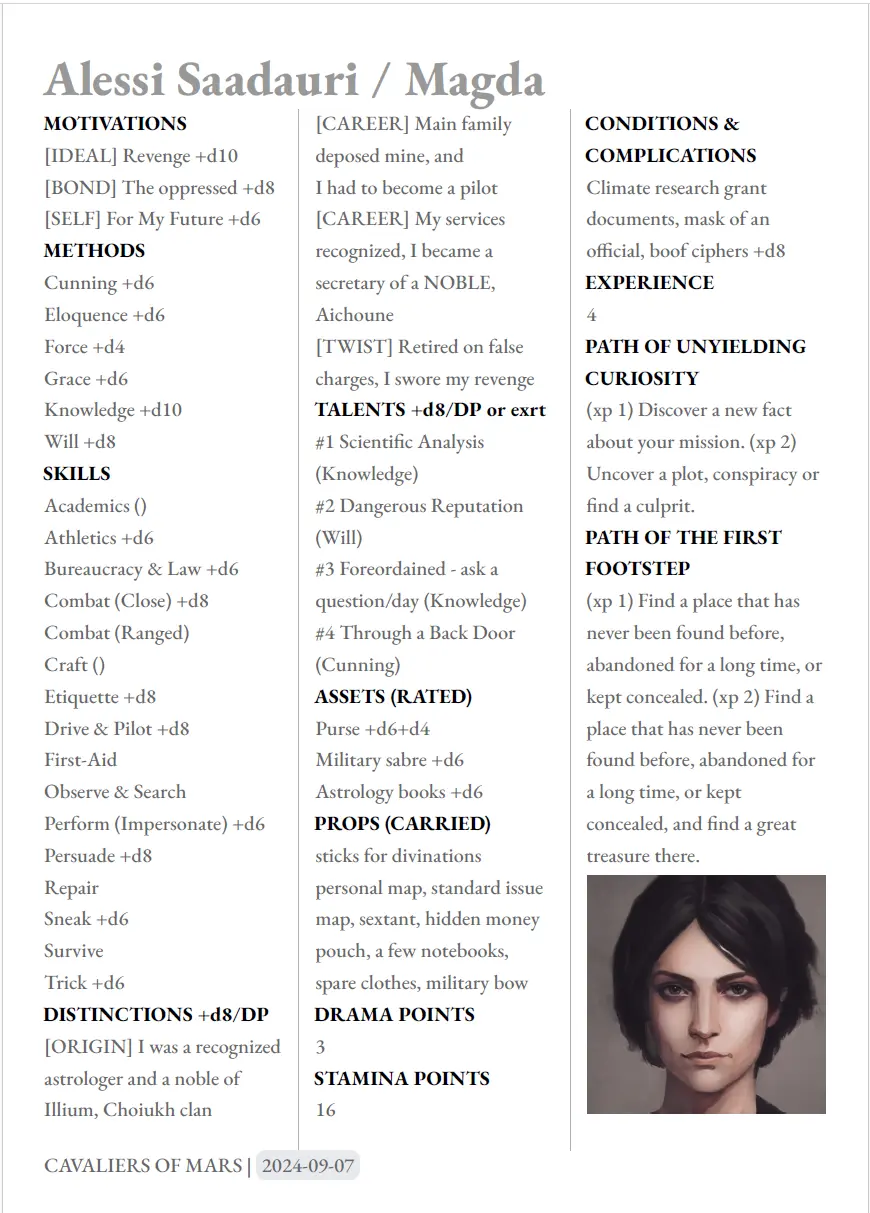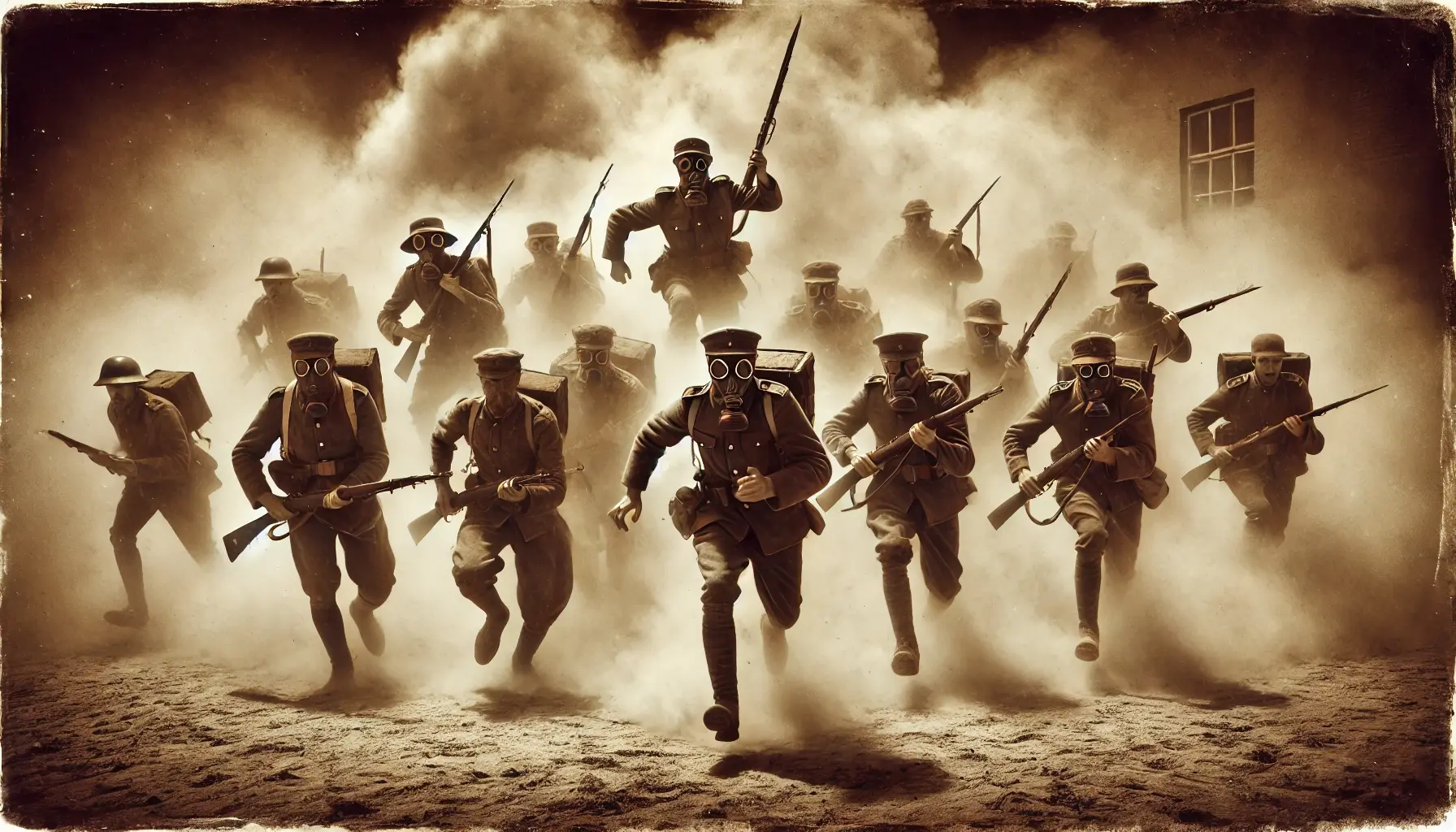Cavaliers of Mars Campaign
The history behind the game
At its core, the original book is about running a game similar to Three Musketeers in John Carter's Barsoom (Mars) with Conanesque savagery and Jules Verne feeling of wonder.
So my game had to be really different. No really. This is just the way I tend do go about games - read into the setting, then take it apart, pick up the things I feel I want to work with, and then reinvent the wheel with spiciness borrowed from my inspirations.
My version of the game started with my undying love for humble beginnings of a revolution against a fascist government, an established yet working order being turned upside down by people who were born there, and feel that a change is due. And then living with the consequences of living with the changes.

I started with the premise of Fullmetal Alchemist - a world run by military junta, good people trying to do right things in dire circumstances, dark secrets of the past hinted in the prologue, and then even darker truths slowly coming to light.
There we have Illium, a polis on a terraformed Mars in a far future. Illium is run by a masked group of individuals, apparently unchanging since like forever. They form a council. Then we have ministries, army and London-like city. The PCs work for a Fahrenheit 451 insitution - a Lost and Found Bureau (under supervision of Ministry of History), an institution tasked with searching for threats of unique nature, and then dealing with them.
The characters start with Basic Orientation Course for Government Employees.
Books and inspirations
The original game is Cavaliers of Mars by Onyx Path Publishing, with credits listing Rose Baily as the Creator, and the additional writers being Onyx Path Publishing staples: Benjamin Baugh, Storn Cook, Steffie de Vaan, Meghan Fitzgerald, Jordan Goldfarb, Danielle Lauzon, Ethan Skemp, Lauren Stone, Travis Stout, and senior writer Audrey Whitman.
The inspirations:
- Edgar Rice Burroughs's Barsoom
- Fullmetal Alchemist
- Alistair MacLean's Guns of Navarone
- H. P. Lovecraft's At the Mountains of Madness
- Spriggan manga
- Robert E. Howard's Black Canaan
The System and the PCs
This is another CortexPrime hack.
About the system: CortexPrime system is quite simple: assemble a dicepool based on your stats, juggle it a bit to improve your chances, roll and then select three dice - add two of them to create your success total, select a third one to find out how well you succeeded. You need to exceed your difficulty number. If you fail, you take consequences (penalties) that accumulate until you're eliminated (it's a system where taking a first loss sets you on a bad path, so you either don't want to take a loss at all, or you want to recover from it as quickly as possible).
PDF charsheets (the characters are as they appear at the end of the campaign, well into the third mission):
- Bubmblebee Mk2, an electric truck and a mobile lab housing character assets
- Lucca Puglessi, an anarchist and a spy
- Osir Yei, an academician assassin
- Alessi Saadauri, an aristocrat, a pilot and a plotter
- Guillame Gavroche, a herb merchant, actually a member of Hungry Brotherhood and a poisoner
The System and the PCs, take two
Having decided that the previous version of the system required too much bookkeeping during round-to-round combat or other conflicts, I have decided to make things slightly simpler. Also, since ideal-based resolution is a bit too monotonous for the characters, we are switching to hitpoints (stamina points), attributes and skills. In other words, there are more choices, and going-ons should be more complicated. Also, we're moving from LibreOffice to Google Docs so that the character sheets can be made available to everyone.

Walking through the character sheet:
- Motivations - when you're doing stuff, you do it because of one of these. If so, any consequences, complications should reflect the one selected for the roll.
- Methods - ye olde attributes.
- Skills - another of the golden oldies.
- Distinctions - pay a Drama Point to invoke a distinction to add something personal to the story. This campaign assumes that all characters had some serious trouble that forced them into employment in Lost and Found Bureau.
- Talents - pay a Drama Point or exert a listed stat to either achieve an automatic success during downtime or gain another d8 on a roll. Like Distinctions, only stronger, more specific.
- Assets (Rated) - list of three tools on a character to aid in specific action. Cash, a weapon and... books in this case.
- Props (Carried) - an item one can use to support an action. If you declare an action, and you fail to show a prop, a GM can refuse or impose a penalty.
- Drama Points - universal narrative currency to allows characters to influence narrative or to escape consequences.
- Stamina Points - Human default for a noncombatant: 6. Easily recoverable with rest unless you're into negatives. At negatives you're wounded and need to get treatment to recover. At -(stamina/2) you're OUT, possibly dead.
- Conditions and Complications - Things that may be limiting the character. Wounds, illegal goods or a secret that may spell doom. Basically, a penalty that is used under suitable circumstances.
- Experience - currency to purchase development for your character.
- Paths - milestones. Score and get xp.
Generally, the game balance is based on the fact that PCs roll more dice but achieve results in the same scope as NPCs. Also, PCs may add more dice to improve their odds. Also, PCs have more stamina points. Also PCs can use Drama Points.
For combat, the characters act first, one by one, with spotlight following every participant. The PCs act in the order of their preference, however a PC must be followed by a member of opposition unless there are circumstances that change that (like surprise, paralysis, shock, etc). The damage dealt is the Effect Die value (for d6 it's 6) plus weapon damage roll minus opponent's Effect Die value. Note that Scale die (i.e. die one gets for outnumbering and attacking together or for being a truck ramming into a human) can be assigned as either additional score die or as an weapon damage die to the roll. Don't fence with groups (+d8 Scale die) and you definitely don't want to be rammed by a truck (+2d8 Scale dice).
Here are the updated characters:
- Aleesi Saadauri
- Bumblebee Mk2 truck
- Guillame Gavroche - switches to supporting NPC role
- Lucca Puglessi
- Osir Yei
- Jayla Smaine - a new player
Campaign materials

- (OBSOLETE) GM screen v07 (rules for the CortexPrime hack) - previous edition of rules.
- GM screen v08 (rules revisited) - a recap of updated rules with sample creatures.
- Character creation manual (rules revisited) - requires original game handbook to use.
- Operation Pilgrim (completed) - presentation + fact sheet.
- Operation Puzzle Box (on hold, restarting...) - presentation + fact sheet.
- Operation Carrot Top (unfinished).